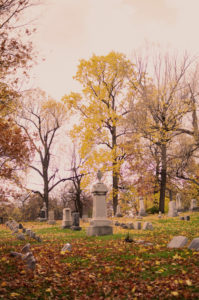
The following feature appears in the Fall 2016 issue of Medley Magazine.
In the heart of the 160-acre cemetery stands a deteriorating chapel. My fellow classmate says dead bodies were stored in there when it was too cold to bury them. In the shade of the adjacent forest, Karli Gasteiger, having survived a “Live Oaks & Dead Folks” tour before, clues us in on what to expect while we await the others. For the next 80 minutes of this mid-September afternoon, our magazine writing class will tour Oakwood Cemetery. Gasteiger halts when two cars roll down the gravel road. Professor Melissa Chessher and the rest of our class emerge from one car. Our guide, a 70-year-old woman named Sue Greenhagen, emerges from the other.
“Her squawking voice competes with the roaring of nearby Interstate 81.”
“Gotta get wired up!” Greenhagen announces as she adjusts her microphone and straps her “shout box” — as she will later call her speaker — to her hip. Her wavy strings of shoulder-length white-blonde hair peek out from under a straw hat with a green ribbon matching her Oakwood shirt. A lanyard hangs from the belt holding her khakis up. Greenhagen welcomes us to Syracuse’s historic cemetery, describing its late 1800s heyday like she lived through it. I raise my eyebrows when she mentions Oakwood served as a destination for Sunday outings away from the city. Her squawking voice competes with the roaring of nearby Interstate 81.
Greenhagen laments that she can’t bring us inside the mortuary chapel since someone changed the locks, and she leads us to our first stop: abolitionist Amos Granger’s grave. There, she recites one of Amos’s speeches for several paragraphs. “Slavery is war, open war, against the rights of man,” she reads, her voice increasingly louder and emphatic with each phrase. The glazed eyes in her audience fail to reflect her enthusiasm. We meander through green hills of gravestones, tombs, and obelisks, meeting a doctor who sold the recently deceased poor to Syracuse University as cadavers and a woman who married the “father of the American Christmas card.”
“We ascend the hill to our next stop, and my drowsiness snaps when I see a man launch himself into a tree.”
My eyelids grow heavy. The rain left hanging in the air from yesterday’s deluge and the gentle sunlight breaking through the clouds lull me to sleep. We ascend the hill to our next stop, and my drowsiness snaps when I see a man launch himself into a tree. Another slouches on the tomb about which Greenhagen starts droning on. Neither man budges, seemingly indifferent toward our presence. However, our first live encounters have become the object of a pop-up paparazzi — phones and cameras materializing. The moment Greenhagen stops talking, we bombard the poor guys with journalistic curiosity.
I chat with the dude on the grave and learn that his name is Nathan. He looks carefree in his backward baseball cap, boat shoes with socks, and jersey. Nathan and his buddy in the tree are sophomores at SU and the State University of New York College of Environmental Science and Forestry, respectively. Ignoring the Resident Advisors’ warnings, he first visited Oakwood after his freshman-year orientation and frequented it ever since, typically on Sundays, with his friends. “It’s more of a park to us than it is a cemetery,” Nathan says, recounting memories of exploring the catacombs, playing football in the fields, sledding and building igloos in the winter, and nighttime drinking and smoking in the company of up to 60 people.
Nathan still hangs out here despite witnessing something spooky. Using two tombs as posts, Nathan’s friends set up a hammock. When both friends climbed in it, their weight pulled down a post — the 500-pound monument of George W. Weed — onto one friend’s leg, crushing it. “It was just really bad karma,” Nathan says, unruffled; I bet Greenhagen would blame Weed’s ghost.
Speaking of Greenhagen, she’s gone — only my classmate Anna Leach and I remain. We hastily wave goodbye to the guys as we hurriedly search for our group. Thankfully we find them, but I struggle to focus on Greenhagen’s “Westcott Curse” theory. I will later Google it and find no results. When she finally concludes the tour, a few pathetic claps chip at the silence. “Make them do more!” Greenhagen urges Chessher. I oblige, but I’m thinking of Nathan, not Greenhagen, as I plan my next Sunday.
written by Erica Petz